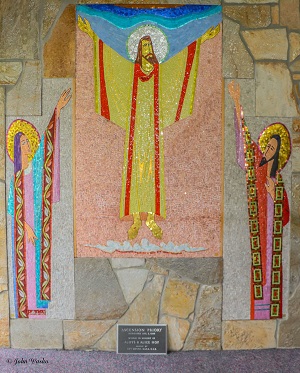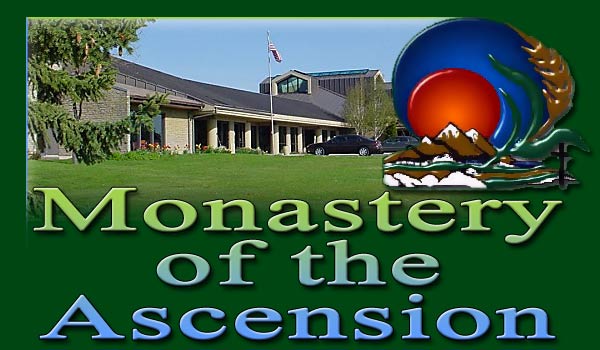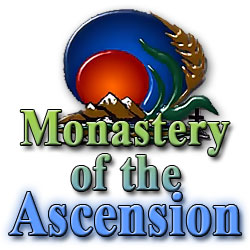The Divine Office of the Liturgy of the Hours
Freddie Nikoloff
History and Theology
The term "Office" comes from the Latin "officium," which means "service." The Divine Office is the service given to God in prayer by the Church. Pope Paul VI calls it the hymn of praise sung through all the ages in the heavenly places and brought by the high priest Christ Jesus into this land of exile. The Liturgy of the Hours (referring to the seven "hours" of prayer) goes back to early Christian times. The Church has continued it with constant fidelity over many centuries in a rich variety of forms.
Gradually, the Office developed into the prayer of the local church, offered at regular intervals and in appointed places, under the presidency of a priest. The books for the Divine Office underwent many revisions. The latest of these was by Decree of the Second Vatican Ecumenical Council, when the Office was considerably abridged and simplified.
The Office is a complement to the fullness of divine worship that is contained in the Eucharistic sacrifice. By the Office the worship of the Eucharist overflows to reach all the hours of daily life.
The Liturgy of the Hours has been drawn up and arranged in such a way that not only clergy but also religious and indeed laity may participate in it, since it is the prayer of the whole people of God. The prayer can be adapted to suit the way of life and vocation of those praying it.
Christian Prayer is above all the prayer of the whole human community, which Christ joins to himself. This prayer takes its unity from Christ, for our Redeemer desired that the life he entered upon in his mortal body, and his sacrifice, should continue without interruption through the ages in his mystical body, the Church.
The whole life of the faithful, hour by hour, during day and night, is kind of leitourgia, or public service. In this service the faithful give themselves over to the ministry of love toward God and men, identifying themselves with the action of Christ, who by his life and self-offering sanctified the life of all humankind.
Jesus has commanded us to do as he did. On many occasions he said: "Pray," "ask," "seek," "in my name." And in the Lord's Prayer he gave us a formula of prayer.
"Let the word of Christ dwell in you in all its richness, as you teach and advise each other in all wisdom by psalms, hymns and spiritual canticles, singing thankfully in your hearts to God" (Col 3:16). The example of Jesus and the early Church provided the pattern of prayer in the Divine Office.
Structure
The Office, while it combines elements found in other Christian celebrations, is arranged according to its own laws. It is so constructed that after a hymn there is always psalmody, then a long or short reading of sacred Scripture and finally, intercessions.
The essential structure of the Liturgy remains the same whether in a celebration in common or in individual recitation. It is a conversation between God and man.
Morning and Evening Prayer are the two chief hours of prayer for the day. Vatican Council II described them as "the two hinges on which the daily Office turns."
These are the parts of Morning and Evening Prayer:
1. Invitatory (invitation to pray): Verse and Response; Psalm and Antiphon 2. Hymn 3. Psalmody: Each Psalm has an Antiphon adapted from a verse in the Psalm 4. Scripture reading 5. Silence following Psalms and readings is an integral part of prayer 6. Response (designed to turn the reading into prayer and contemplation) 7. Gospel canticles: Benedictus (Luke 1: 68-79) at Morning Prayer; Magnificat (Luke 1: 46-55) at Evening Prayer 8. Intercessions 9. Lord's Prayer 10. Concluding Prayer 11. Blessing.
The psalmody follows a four-week cycle.
In addition to Morning Prayer (Lauds) and Evening Prayer (Vespers), the full form of the Office includes three times of prayer during the day (before Noon, Midday, Afternoon) plus the Office of Readings and Night Prayer (Compline).
The structure of the Prayers during the day is similar to that in Morning and Evening Prayer, but is somewhat shorter.
The Office of Readings follows a straightforward pattern of hymn, psalmody (3 psalms), two substantial readings (each with their own responsory), and concluding prayer. The purpose of the Office of Readings is to present to the people of God a more extensive meditation on Sacred Scripture and on the best writings of spiritual authors.
Night Prayer, to be said at bedtime, is brief. The psalms and Scripture all serve to strengthen our hope in the Risen Christ and to help us rest with him in peace.
The fundamental purpose of a Benedictine community is to offer praise to God in prayer and work, and to strive for holiness. At the center of daily activities are the Eucharist and the Liturgy of the Hours, which punctuate the day and consecrate time itself. The same, depending on individual circumstances, applies to oblates of St. Benedict.
Oblates are encouraged to fulfill the Church's Office by celebrating at least part of the Liturgy of the Hours.
The Divine Office was and still is the backbone of any Benedictine community and is at the heart of any individual whose spirituality is based on the Benedictine way. Those who follow the way of Benedict are necessarily men and women of prayer.
The writer of these lines loves to pray the Office, whenever possible, at the same hours as scheduled at the Monastery. This gives her the illusion of closeness to her "oasis."


